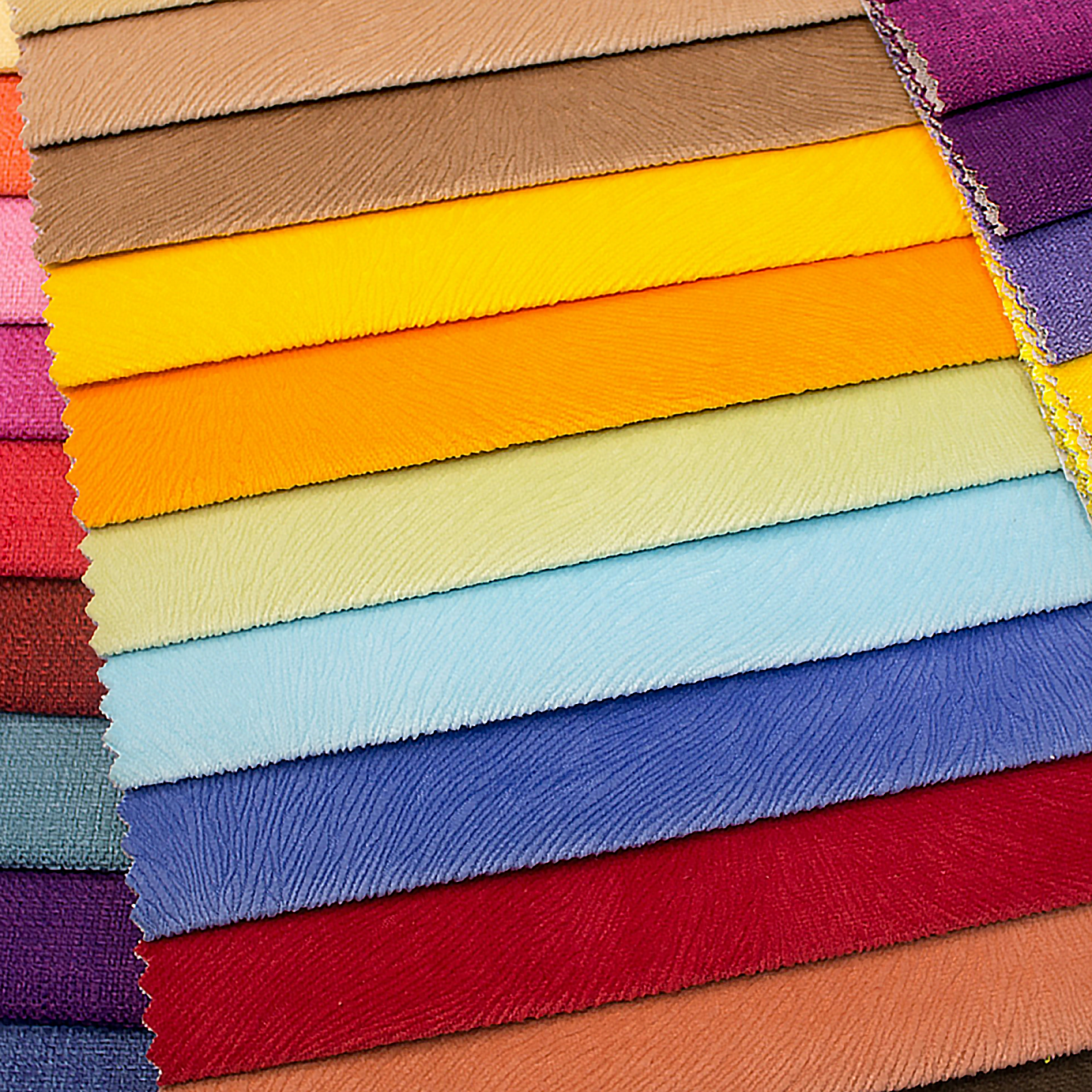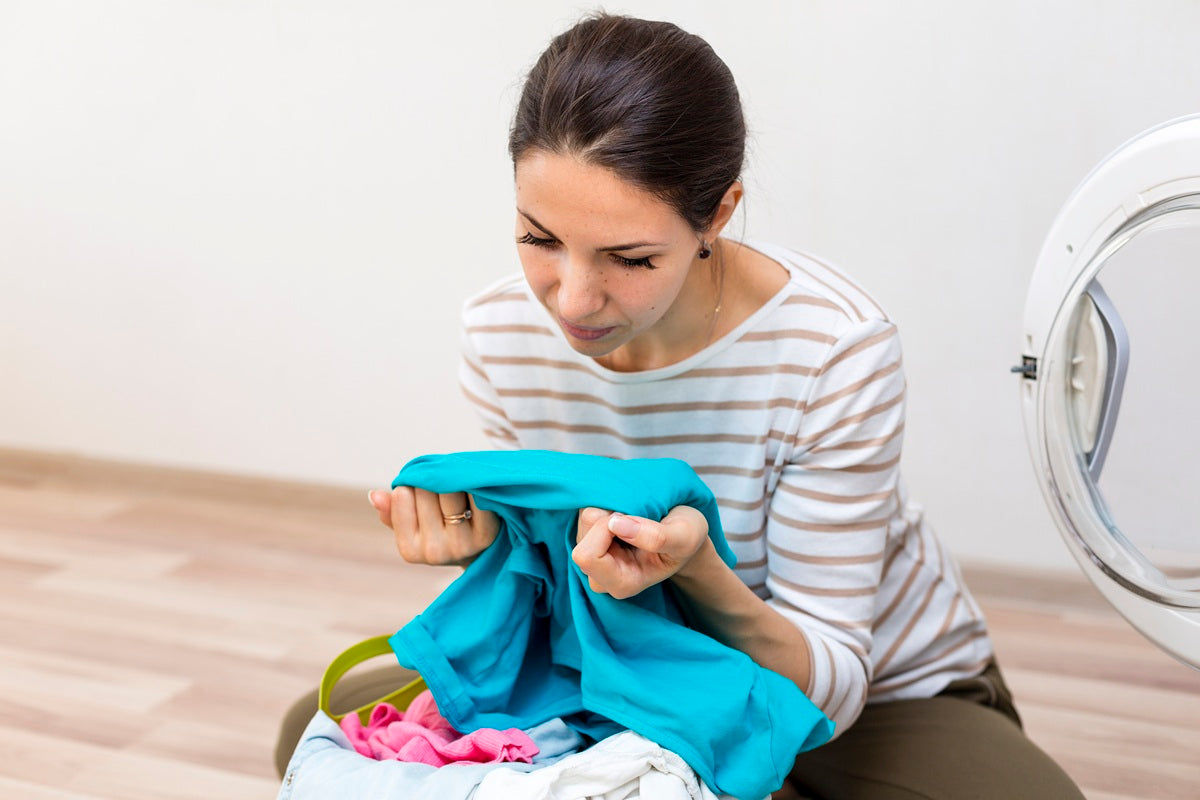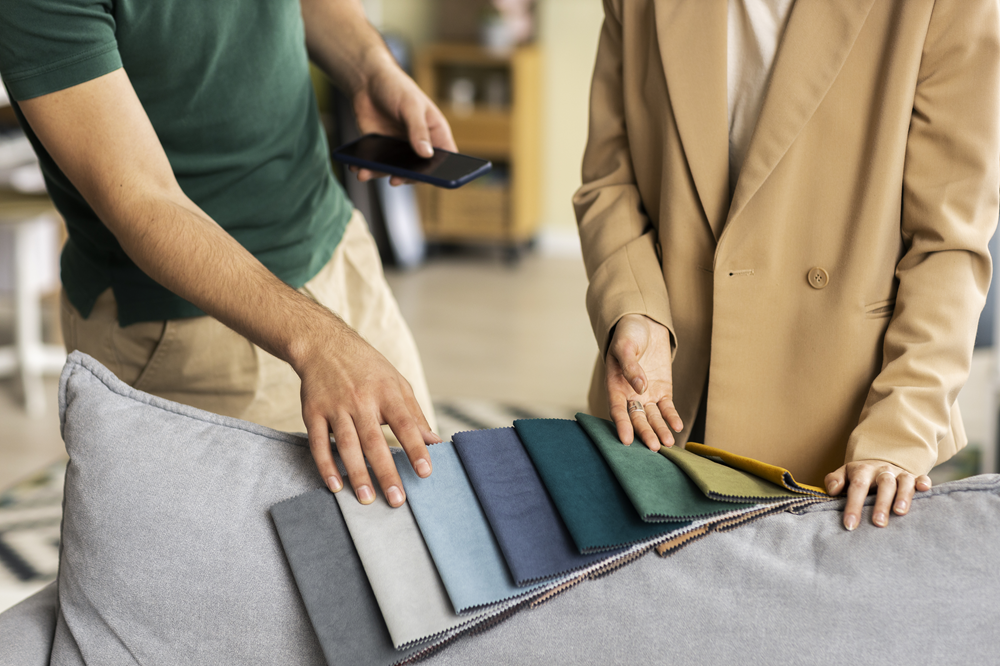Velvet speaks a different language depending on the color you choose. A midnight blue velvet catches light like water at dusk. Deep burgundy reads warm and grounded. Soft blush pink feels modern, almost weightless.
The pile structure of velvet, those thousands of tiny vertical fibers, absorbs and reflects light in ways that flat-weave fabrics can’t touch. So when you ask what colors velvet comes in, the real answer is this: velvet comes in every color you can imagine, and each one performs differently under your hand, under studio lights, and in finished garments or upholstery.
This guide explores what makes velvet unique, including how color interacts with pile and fiber content, and identifies which shades work best for different applications.
What Makes Velvet Unique
1. Soft Pile and Plush Texture
Velvet is woven using a double-cloth construction. Two layers are created simultaneously on a loom, connected by vertical threads that get cut to form the pile. That’s what gives velvet its signature softness. Those short, dense fibers stand upright and create a surface that feels cushioned and smooth. The pile also gives velvet its directional quality. Brush your hand one way and it darkens. Brush it back and it lightens. That’s the nature of the weave.

The texture is part of the appeal, but it also dictates how color shows up. A smooth pile reflects light more evenly, so colors look cleaner and more saturated. A crushed or distressed pile scatters light, which gives you that marbled, multi-tonal effect. If you’re working with solid-colored velvet, the texture will shift how that color reads under different angles and lighting conditions.
2. Light Reflection
Velvet doesn’t just hold color. It plays with it. The pile structure catches light at different angles, which creates depth and dimension that you don’t get with cotton twill or polyester satin. A flat red fabric looks red. A red velvet looks like it has shadows built into it. That’s the magic of pile.

Arresting wine stretch velvet fabric by the yard
3. Durability and High-Quality Weave
Velvet has a reputation for being delicate, but that’s not always true. The durability depends on the fiber content and the weave density. A well-constructed velvet with a tight pile and strong backing can handle heavy use. We stock velvet suitable for upholstery, which means it’s built to take friction, weight, and daily contact without pilling or flattening.
The weave also affects how well the fabric holds dye. A dense weave with high-quality fiber will maintain color saturation longer. Cheaper velvets, especially those made from loosely woven synthetic blends, can fade or lose their sheen after a few washes or months of sunlight exposure. If you’re working on a project that needs to last, the quality of the velvet matters just as much as the color you choose.
Popular Velvet Fabric Colors for Every Design Need
Timeless and Elegant Shades
1. Deep Blue Velvet
Navy and midnight blue velvet have a quiet richness that works in both traditional and modern settings. The color feels serious and grounded, which makes it a strong choice for upholstery, blazers, and evening gowns.

Blue disco dot stretch velvet fabric by the yard
Blue velvet holds dye beautifully, so the color stays saturated and doesn’t fade as quickly as lighter tones. It pairs well with gold, brass, and warm wood finishes, and it photographs beautifully in natural light.
2. Emerald Green Velvet
Emerald green feels bold without being loud. It’s one of those colors that adds personality to a room or an outfit without overwhelming the rest of the design. We see emerald green velvet fabric by the yard used in dining chairs, accent pillows, and statement jackets. It works especially well in spaces with warm neutrals or brass hardware. The depth of green in velvet gives it a jewel-like quality that flat fabrics can’t match.
See how it looks:

Emerald green print velvet fabric by the yard
3. Burgundy or Wine Velvet
Burgundy velvet is a classic for a reason. It feels warm, luxurious, and a little dramatic. You’ll see it in theater seats, holiday collections, and high-end furniture lines.

Wine multi HG glitter velvet fabric by the yard
The color works well in low-light environments because it doesn’t disappear into the shadows like darker blacks or browns might. Burgundy also pairs beautifully with metallics, creams, and darker woods.
Modern and Trendy Velvet Colors
4. Blush Pink Velvet
Blush pink has been popular for the past few years, and it’s not going anywhere. The color feels soft and modern, and it works in both residential and commercial spaces.

Blush pink blitz velvet fabric by the yard
A blush pink velvet sofa can anchor a living room without feeling too feminine or overly trendy. In apparel, blush pink velvet works well for dresses, wide-leg pants, and blazers that need a softer, more approachable feel.
5. Mustard Yellow Velvet
Mustard yellow is warm, saturated, and unexpected. It brings energy to a space without feeling too bright or childish. We see mustard yellow velvet used in accent chairs, throw pillows, and statement coats. It pairs well with deep blues, charcoal grays, and natural woods.
If you’re looking for a color that stands out but still feels grounded, mustard yellow is a strong choice.
6. Sage Green Velvet
Sage green is quieter than emerald but still has presence. It feels fresh and calming, which makes it a good fit for bedrooms, lounges, and casual apparel.

Sage green stretch velvet fabric by the yard
Sage green velvet works well in spaces with lots of natural light and organic materials like linen, cotton, and wood. It’s also a good alternative to gray if you want something neutral but not quite as cool-toned.
Neutral and Versatile Velvet Tones
7. Charcoal Gray Velvet
Charcoal gray is one of the most versatile colors we stock. It reads modern and sophisticated, and it works in almost any setting. Gray velvet doesn’t compete with other colors in the room, so it’s a safe choice for commercial projects or rental properties where you need broad appeal.

Coal gray, Coco organic breeze sequin fabric by the yard
It also photographs well, which makes it a good option for furniture lines or apparel collections sold online.

Gracious charcoal stretch velvet fabric by the yard
8. Ivory and Cream Velvet
Ivory and cream velvet feel soft, open, and timeless. They work well in minimalist spaces or as a base for layered textile designs. The lighter pile reflects more light, so these colors can make a room feel larger and brighter.

Elegant pearl monsoon glitter ice velvet fabric by the yard
In apparel, cream velvet works beautifully for bridal separates, blazers, and wide-leg trousers that need to feel elegant but not overly formal.
9. Taupe and Beige Velvet
Taupe and beige sit somewhere between gray and brown. They feel warm and neutral at the same time, which makes them easy to work with. These colors blend into most palettes without disappearing, and they age well. A taupe velvet sofa can handle years of use without looking dated or worn out. In fashion, taupe velvet fabric by the yard works well for outerwear and accessories that need to feel refined but not flashy.

Latte stretch velvet fabric by the yard
How Color Affects Velvet’s Appearance
1. Light Absorption and Shimmer Effect
Velvet absorbs light differently from smooth fabrics. The pile traps some of the light while reflecting the rest, which creates that signature soft glow. Darker colors absorb more light, so they feel deeper and more saturated. Lighter colors reflect more, which gives them a brighter, airier quality.

The shimmer effect is more noticeable in medium to light tones. A pale gold velvet will catch the light and almost glow under certain conditions. A navy velvet will look rich and dimensional, but the shimmer is more subtle.
If you want a fabric that shifts dramatically with movement and lighting, go for jewel tones or metallics. If you want something more understated, neutrals or darker shades will give you that quiet richness without too much visual noise.
2. The “Crushed Velvet” and “Silk Velvet” Color Sheen
Crushed velvet has been treated to create an irregular, multi-directional pile. The fibers are pressed or twisted, which gives the fabric a textured, almost marbled appearance. Color in crushed velvet looks more varied because the pile reflects light in different directions. A solid burgundy crushed velvet might read as burgundy, wine, and even a bit of plum, depending on the angle.

Silk velvet, on the other hand, has a smoother, more uniform sheen. The pile is finer and more consistent, so the color looks cleaner and more saturated. Silk velvet feels more formal and refined. It’s often used in high-end fashion and luxury interiors where the goal is to create a polished, elegant look.
The sheen is softer than satin but more pronounced than cotton velvet. If you’re comparing silk velvet to polyester velvet, the difference is in the depth of color. Silk holds dye better and has a natural glow that synthetic fibers can’t fully replicate.
3. Influence of Fiber Type (Cotton, Polyester, Silk) on Hue Depth
The fiber content affects how the dye takes and how the color holds over time. Silk velvet has the richest color saturation because silk fibers absorb dye deeply and evenly. The result is a fabric that looks luminous and feels incredibly soft. Cotton velvet has a more matte finish, which gives the color a softer, less reflective quality. It’s still beautiful, but it reads more casual and less formal than silk.
Polyester velvet is the most common type we stock because it’s durable, affordable, and easy to care for. Polyester doesn’t absorb dye the same way natural fibers do, so the color sits more on the surface. That means it can fade faster with sunlight exposure or repeated washing. But it also means you can achieve brighter, more saturated colors that would be harder to get with cotton or silk. If you need a bold, high-impact color for upholstery or costumes, polyester velvet gives you that punch without the cost of silk.
Factors That Influence Velvet Fabric Colors
1. Type of Velvet and Fiber Content
The type of velvet you choose affects how the color looks and how long it lasts.
Silk velvet has the richest, most saturated colors because silk fibers absorb dye deeply. Cotton velvet has a softer, more matte finish, which gives colors a more subdued quality. Polyester velvet can handle brighter, bolder colors, but the dye sits more on the surface, so fading can happen faster with prolonged sunlight exposure.
If color accuracy and longevity matter for your project, ask about the fiber content before you order. A silk-blend velvet will hold color longer and feel more luxurious, but it will also cost more. A polyester velvet offers more color options at a lower price point, but be aware that you may need to plan for color shifts over time.
2. Dyeing and Manufacturing Process
Velvet can be piece-dyed or yarn-dyed. Piece-dyeing means the fabric is woven first and then dyed as a finished piece. This method is faster and more cost-effective, but the color penetration isn’t as deep. Yarn-dyeing involves dyeing the fibers before weaving, resulting in richer, more consistent color throughout the fabric. Yarn-dyed velvet holds up better over time and is less likely to fade with washing or sunlight exposure.
The quality of the dye also matters. Higher-quality dyes are more colorfast, meaning they won’t bleed, fade, or change tone as quickly. If you’re working on upholstery that will be in direct sunlight or garments that will be washed frequently, ask about dye quality and colorfastness ratings.
3. Care and Maintenance
Velvet holds color well if you care for it properly. Most velvet should be spot cleaned or dry cleaned to avoid damaging the pile or causing uneven color fading. If you’re working with polyester or cotton-blend velvet, some pieces can be machine-washed on a gentle cycle, but always test a swatch first.
Sunlight is the biggest enemy of colored velvet. Prolonged exposure to direct sunlight will fade almost any color, especially lighter tones and brighter hues. If you’re using velvet for drapery or upholstery near windows, consider UV-protective treatments or rotate the fabric periodically to avoid uneven fading.
How to Choose the Perfect Velvet Fabric Color
1. For Upholstery Projects
Think about the room’s lighting, the existing color palette, and how much wear the piece will get.
For example, darker colors hide stains and wear better than lighter tones, so they’re a practical choice for high-traffic furniture. Jewel tones like emerald, sapphire, and burgundy add personality without overwhelming the space. Neutrals like charcoal, taupe, and cream work well if you want the furniture to blend into a wider design scheme.
If you’re upholstering a full sofa or sectional, order a large swatch and live with it in the space for a few days. Look at it in the morning, in the afternoon, and at night under different lighting. That’s the only way to know if the color will work long-term.
2. For Fashion or Apparel
Consider the season, the silhouette, and the overall mood of the collection.
Deep colors like navy, burgundy, and forest green work well for fall and winter lines. Lighter colors like blush, cream, and sage green feel more appropriate for spring and summer. If you’re designing eveningwear, jewel tones and metallics photograph beautifully and feel formal. For casual apparel, neutrals and softer tones keep the look approachable.
Pay attention to nap direction when cutting velvet for garments. The color will shift depending on which way the pile runs, so all pattern pieces need to be cut in the same direction for a consistent look.
3. For Interior Design
Match the velvet color to the room’s function and lighting.
A bedroom benefits from softer, calming tones like sage green, blush pink, or taupe. A living room or dining area can handle bolder colors like emerald, mustard, or deep blue. If the room gets a lot of natural light, test the color in that lighting before committing to yardage.
Layer velvet with other textures like linen, cotton, and wood to keep the space from feeling too heavy or one-note. A velvet accent chair in a bold color works well next to a neutral linen sofa. A few velvet pillows add warmth and texture without dominating the room.
Where to Shop Velvet Fabric by the Yard
At Zelouf Fabrics, we stock velvet in dozens of colors across multiple weights, fiber blends, and finishes. Our catalog includes stretch velvet, crushed velvet, silk-blend velvet, and performance velvet suitable for upholstery. Everything is available by the yard, in stock, and ready to ship directly to you.
We work with fashion designers, furniture manufacturers, and interior decorators who need reliable fabric at scale. Our filters make it easy to shop by color, weight, or fiber content. Once you’re ready to move forward, you can request a FREE swatch (just pay shipping) to preview the color and texture under your own lighting before ordering yardage.




